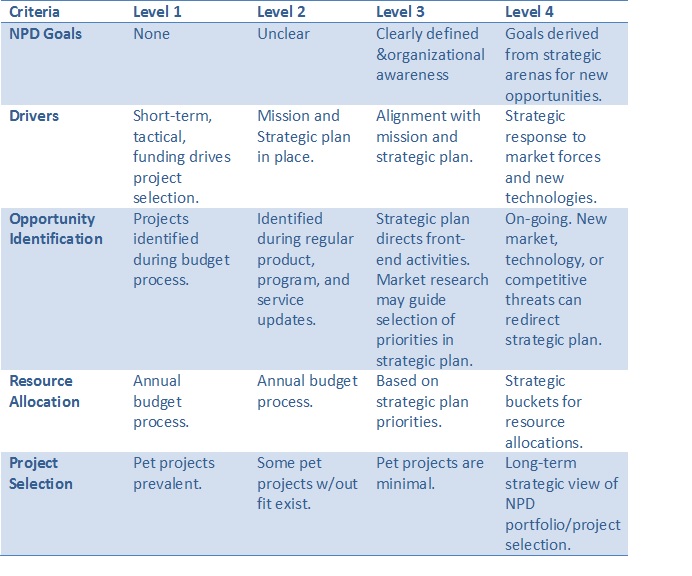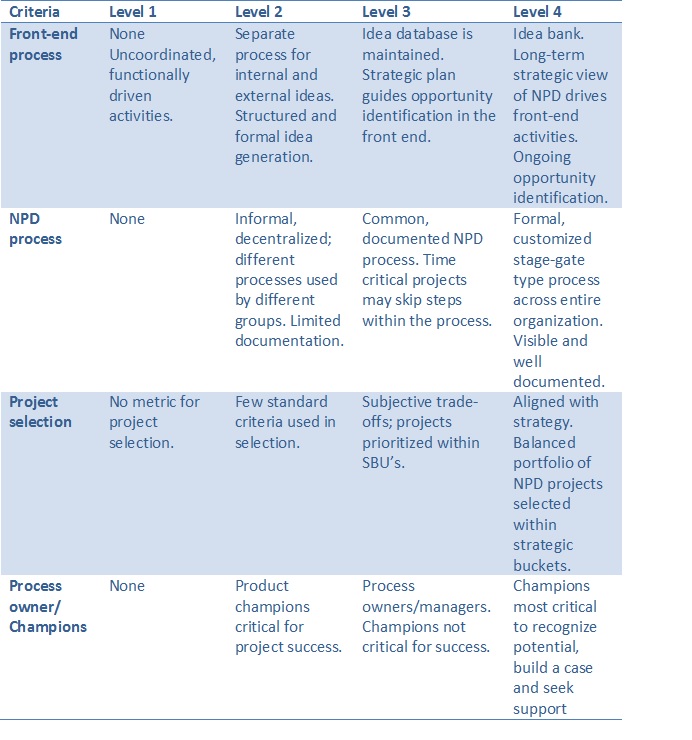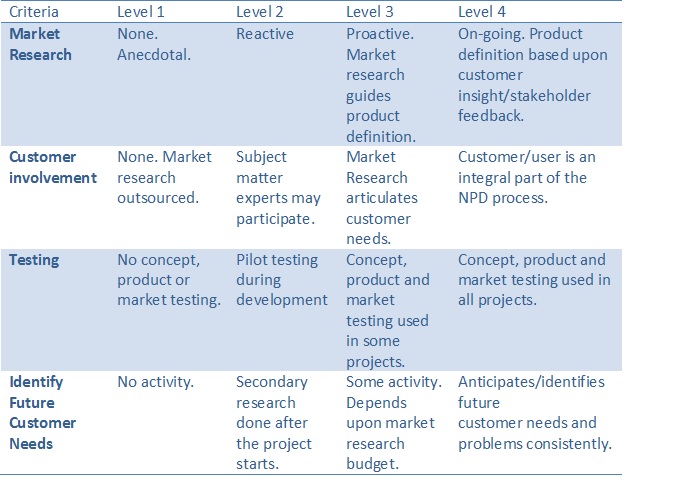Innovation has become a popular term and in the process has lost much of its meaning. In this article Dr. Thota defines “innovation” and applies maturity framework to assess innovation capabilities in SMEs. Outstanding SMEs operate at maturity level four while the “rest” operate at varying levels of maturity between one and three. Moving from level one to level four is tedious and time consuming and requires strong leadership and commitment of resources.
SMEs profit from innovation with the sale of new products, services, technologies, cost savings, quality enhancements and process improvements. They may also utilize new strategies and business models to increase the breadth and depth of offerings in existing markets as well as create new markets.
Innovation, categories of innovation and types of innovation projects
The Product Development and Management Association (PDMA) defines innovation as “a new idea, method or device. The act of creating a new product or process. The act includes invention as well as the work required to bring an idea or concept into final form.”. To create new products, technologies and processes SMEs can utilize three categories of innovation and seven types of innovation projects.
Three categories of innovation are:
- Radical Innovations
- More Innovative Products/Services
- Incremental Products/Services
Seven types of innovation projects are:
- New-to-the World Products
- Breakthrough Products
- New Product Lines to SME
- Additions/Major revisions to Existing Product Lines
- Incremental Improvements
- Repositioning existing products
- Cost Reductions
Innovation capability of SMEs can be assessed utilizing the innovation maturity framework. This framework offers a structured approach to measure maturation to develop new products and services throughout the SME lifecycle. Innovation performance can be benchmarked with the best NPD practices SMEs.
Innovation Maturity Framework
In the innovation maturity framework, assessment begins with the evaluation of SME’s focus, values, and value proposition followed by assessment of maturity in the use of strategy, process and tools.
Assessment of SME Focus and Values
SMEs have lifecycles. The lifecycle has four phases. Each phase of SME lifecycle is characterized by different governing values and focus.
Phase 1: Entrepreneurial phase- is characterized by creativity and risk taking.
Phase 2: Growth phase- is characterized by innovation.
Phase 3: Mature phase- is characterized by productivity improvements.
Phase 4: Decline phase- is characterized by focus on increasing volume, and decrease in costs.
To become successful, SMEs operating in phase 3 of the lifecycle must learn to innovate in addition to making productivity improvements. This requires leadership. Leadership actions to prepare SME for growth can be assessed by strategies, goals and actions implemented to deliver offerings with strong value proposition to target customers.
1. Strategy: Assess if the leadership implemented a realistic strategy and defined environmental conditions under which SME aspires to become either a market leader, fast follower, or cost leader. For example, the strategy can articulate how SME will become the first to launch most innovative offerings into the market utilizing new designs, technologies, processes and/or new materials.
2. Goals: Assess if leadership has established profit goals from innovation projects and how those goals compare with heuristics such as the rule of ¼ and ¾. ¼- 25% profit goal from new to the world, breakthrough and new product lines to SMEs and ¾ -75% profits from additions/ major revisions to current products, incremental improvements, repositioning existing products, and cost savings/process improvements.
3. Value Proposition: Assess the process and tools the SME utilizes to develop deep insights into how its offerings do the jobs for their owners and how the SME can improve them to do more jobs for their owners, and do them better.
Assessment of Value Proposition
Outstanding SMEs develop a simple, focused value proposition for new products and services that is rooted in deep, certain knowledge about target customers and a realistic appraisal of SME network capacity to deliver. SME’s capability to differentiate from competition can be assessed by asking critical questions such as:
1. How do you identify the target customers for your product/service/education offering?
2. What are the critical benefits of your offering? Does it create enough value for your target customers (so they will purchase your offering rather than a competitor’s solution)? What is the evidence?
3. What criteria do you use to make choices that create value for the offering’s owner?
4. What criteria do you use to assess what makes an acceptable impact to target customers?
5. What is your capacity to produce these benefits cost-effectively and price them correctly?
Assessment of NPD Strategy
NPD strategy maturity can be assessed with five criteria across four levels of maturity. The five criteria are: NPD goals, drivers, opportunity identification, resource allocation and project selection. In level four SMEs, a well-defined strategy directs people and integrates innovation efforts throughout the enterprise. Also, level four SMEs are agile. New opportunities, new technologies, new markets or emerging threats can redirect strategic deployment of their resources. They are proactive. In contrast, level one SMEs are reactive and do not act until forced upon by Michael Porter’s five forces. Level one SMEs do not have clearly articulated NPD goals; short term, tactical factors drive decision making to fund NPD projects, and championing for pet projects becomes a well accepted NPD norm. In level two SMEs, NPD goals are driven functionally with marketing, sales, and product development functions identifying opportunities at regularly scheduled quarterly, semi-annual and annual events. In level three SMEs NPD goals are aligned with strategy, and market research guides selection of arenas of opportunities identified in the strategic plan.
TABLE 1: Assessment of NPD Strategy Maturity Level in SMEs
Assessment of Innovation Process
Innovation process consists of three distinct parts: the front end of innovation; new product development, and back end of innovation consisting of launch and post launch iteration. The front-end activities are distinctly different from new product development activities. Primary activities in the front end include recognizing the business potential, developing business potential, conducting market research to generate deep customer insights, and business case development. Outputs from the front end are new product or technology development projects that go either into the product or technology development pipelines. Majority of SMEs lack effective front-end process and work done in the front-end is not assigned to teams even though they may have a mature stage-gate type NPD process in operation. A formal front-end process linked to a flexible NPD process is essential to develop SME capabilities for launching incremental and more innovative products.
Table 2: Assessment of Innovation Process Maturity Level in SMEs
Assessment of Tools
SMEs use a wide variety of tools to support cross-functional teams working on innovation projects. Level four SMEs utilize a variety of effective market research tools, engineering design tools and technology and organizational tools to involve customers throughout the development process. Following is the framework to assess SME maturity level in the use of market research tools.
Assessment of Market Research Tools
SMEs differ in their sophistication to utilize market research techniques such as the concept testing, product testing, and market testing to determine product definition and customer response. Level four SMEs invest resources to learn customers’ articulated and unarticulated needs (jobs to be done), problems, and benefits; customer responses to the proposed new offering, price sensitivity, market size and potential; and projected sales revenues. In level four SMEs market research activity becomes an integral part of the innovation process. Level one SMEs are internally focused and utilize current problems and current needs to identify opportunity areas for NPD. Level two SMEs utilize market research reactively. During NPD they rely heavily on pilot testing or product testing to obtain customer feedback. Level three SMEs utilize market research proactively. They use customer insights to develop product definition and routinely use concept testing, product and market testing across innovation projects.
Table 3: Assessment of SME Maturity Level-Market Research Tools
Comments
The Innovation maturity framework lays out a course of action SMEs may undertake to improve innovation and NPD capabilities. Vast majority of SMEs operate at innovation maturity levels between one and two. It is much easier task to transition from level one to level two maturity level while progression from level two to level three, and from level three to level four capabilities becomes increasingly difficult. SMEs operating at level four capabilities consistently outperform rivals and deliver strong innovation/NPD results. In some cases level three capabilities may be sufficient to outlast SME’s rivals.
 Dr. Hamsa Thota is the president of Innovation Business Development, Inc., an innovation performance training and consulting company in the USA. He was past president and chairman of the Product Development and Management Association (PDMA) and most recently served as the secretary of PDMA Research Foundation (2006-2012). He is advisor to the “Art of Science Learning” project (2012-2016), a US National Science Foundation (NSF) funded project to spark creativity in Science, Technology, Engineering and Mathematics (STEM) education and the development of an innovative 21st century STEM workforce. He was a visiting professor at the Management School of the Zhejiang Univeristy and an honorary professor at the Geely Automotive Engineering Institute in China. He is co-author of “Key Concepts in Innovation”, a fundamental reference book for professionals involved in innovation and NPD.
Dr. Hamsa Thota is the president of Innovation Business Development, Inc., an innovation performance training and consulting company in the USA. He was past president and chairman of the Product Development and Management Association (PDMA) and most recently served as the secretary of PDMA Research Foundation (2006-2012). He is advisor to the “Art of Science Learning” project (2012-2016), a US National Science Foundation (NSF) funded project to spark creativity in Science, Technology, Engineering and Mathematics (STEM) education and the development of an innovative 21st century STEM workforce. He was a visiting professor at the Management School of the Zhejiang Univeristy and an honorary professor at the Geely Automotive Engineering Institute in China. He is co-author of “Key Concepts in Innovation”, a fundamental reference book for professionals involved in innovation and NPD.






